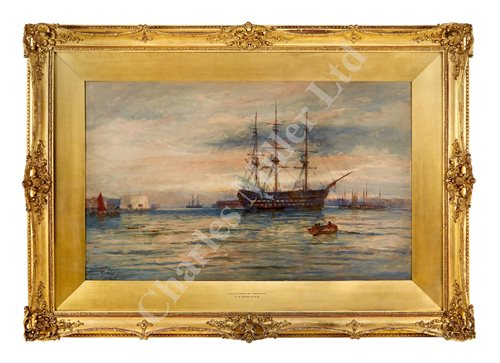2nd May, 2017 12:00
Maritime and Scientific Models, Instruments & Art ('Hibernia')
48
[M] THOMAS BUSH HARDY (BRITISH, 1842-1897)<br/>H.M.S....
H.M.S. 'St. Vincent' Off Portsmouth at Sunset
Signed and inscribed 'T B Hardy / HMS St. Vincent, Portsmouth' (lower left)
Watercolour
26 x 41in. (66 x 104cm.)
H.M.S. St. Vincent, a large First Rate of 2,612 tons and designed to mount 120 guns, was laid down at Plymouth in May 1810 and launched on 11th March 1815. By that date however the Napoleonic Wars were effectively over and, with plans already in hand to reduce the activities of the fleet, she was laid up "in Ordinary" until first commissioned in February 1831 for service with the Mediterranean Fleet. Almost wrecked in February 1834 when she was driven ashore during a tremendous storm off Malta, she was eventually refloated and returned home where she was paid off. Recommissioned for the Channel Squadron in 1841, she was frequently in Portsmouth where she was twice visited by Queen Victoria in 1842 and 1847. During the 1842 visit, she acted as flagship to the 'Experimental Squadron' at the last Royal Review of a fleet in which all the major vessels were sailing ships.
After minor alterations in 1850, she took part in the war in the Baltic in 1854 having first carried 1,300 French troops from Calais for the offensive in the Aland Islands. When Bomarsund, the principal fortress there, surrendered on 16th August, St. Vincent returned to Portsmouth with Russian prisoners-of-war aboard her, this operation marking the end of her sea service. Re-employed first as Guardship of the Ordinary and then as Reserve Depot Ship at Portsmouth, in 1862 she became a training ship for boys and was given a permanent mooring off the entrance to Haslar Creek in Portsmouth Harbour where she is depicted in this picture, attended by a steam launch. Eventually worn out by generations of naval apprentices, she held her last passing-out parade on 18th December 1905 and, on 1st March 1906, was removed from her moorings prior to being towed to Falmouth where she was broken up that summer.
Condition Report
Original condition, not removed from original frame,
We are pleased to provide you with a general report of the condition of this property. Since we are not professional conservators or restorers, we urge you to consult with a restorer or conservator of your choice who will be better able to provide a detailed, professional report. Prospective buyers should inspect each lot to satisfy themselves as to condition and must understand that any statement made by Charles Miller Ltd is merely a subjective, qualified opinion. Prospective buyers should also refer to any Important Notices regarding this sale, which are printed in the Sale Catalogue. NOTWITHSTANDING THIS REPORT OR ANY DISCUSSIONS CONCERNING A LOT, ALL LOTS ARE OFFERED AND SOLD “AS IS” IN ACCORDANCE WITH THE CONDITIONS OF BUSINESS PRINTED IN THE SALE CATALOGUE.
H.M.S. 'St. Vincent' Off Portsmouth at Sunset
Signed and inscribed 'T B Hardy / HMS St. Vincent, Portsmouth' (lower left)
Watercolour
26 x 41in. (66 x 104cm.)
H.M.S. St. Vincent, a large First Rate of 2,612 tons and designed to mount 120 guns, was laid down at Plymouth in May 1810 and launched on 11th March 1815. By that date however the Napoleonic Wars were effectively over and, with plans already in hand to reduce the activities of the fleet, she was laid up "in Ordinary" until first commissioned in February 1831 for service with the Mediterranean Fleet. Almost wrecked in February 1834 when she was driven ashore during a tremendous storm off Malta, she was eventually refloated and returned home where she was paid off. Recommissioned for the Channel Squadron in 1841, she was frequently in Portsmouth where she was twice visited by Queen Victoria in 1842 and 1847. During the 1842 visit, she acted as flagship to the 'Experimental Squadron' at the last Royal Review of a fleet in which all the major vessels were sailing ships.
After minor alterations in 1850, she took part in the war in the Baltic in 1854 having first carried 1,300 French troops from Calais for the offensive in the Aland Islands. When Bomarsund, the principal fortress there, surrendered on 16th August, St. Vincent returned to Portsmouth with Russian prisoners-of-war aboard her, this operation marking the end of her sea service. Re-employed first as Guardship of the Ordinary and then as Reserve Depot Ship at Portsmouth, in 1862 she became a training ship for boys and was given a permanent mooring off the entrance to Haslar Creek in Portsmouth Harbour where she is depicted in this picture, attended by a steam launch. Eventually worn out by generations of naval apprentices, she held her last passing-out parade on 18th December 1905 and, on 1st March 1906, was removed from her moorings prior to being towed to Falmouth where she was broken up that summer.
Auction: Maritime and Scientific Models, Instruments & Art ('Hibernia'), 2nd May, 2017
